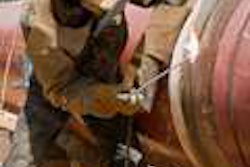By Marcia Gruver
Good used machines are at a premium these days, so it was the luck of the draw that we got to inspect not one, but two small dozers at the Tractor & Equipment yard in Birmingham, Alabama. Sitting side by side were a Komatsu 78-horsepower D31PX-22 with 500 hours and a 110-horsepower D41E-6C with 1,400 hours. Calling on his more than 30 years experience, Larry D. Foltz, district manager for Komatsu America, gave us an overview of both machines, and started out the inspection by verifying their serial numbers and hours. Next up: the walk around.
Walk around
Machine inspections start with a walk around, which allows you to get an overall sense of the machine’s condition. First, note what’s on the dozer. What kind of blade does it have? Is there a winch or a ripper? Is the ROPS open or enclosed? Both of our machines had a power angle tilt blade with an open canopy. If either of them had had a ripper or an enclosed cab, the final price would have been adjusted upward.

Examine all blade cylinders, hoses and pins. Are any of the cylinders dented or damaged? Has the chrome on the cylinder rods been scratched? If so, leaks will either be already present or eminent. If oil can get out, dirt can get in. Next, check the blade itself – are there any welds or cracks? Are the edges worn – if so, can they be turned? Are the blade pins and bushings tight? Any patches, visible cracks, welds or plates on the push arms? Check the trunnion or pivot point for wear. Are shims available to allow for adjustment? Do the blade grease points show signs of recent greasing?
Obvious signs of abuse on a dozer center around the blade and undercarriage, Foltz says. If you see punctures in the skin of the blade, or it’s ripped or indented, it may be a sign that it’s been pushing another machine or working in severe rock. “The external appearance on a machine will tell you a lot,” he says. “I’ve seen machines come in with no grab handles, knocked off guarding around the lights, bolts missing or engine hood covers are damaged or broken. Heavy rock applications or situations where contractors used too small of a dozer for the application will make the machine show advanced signs of wear.”









